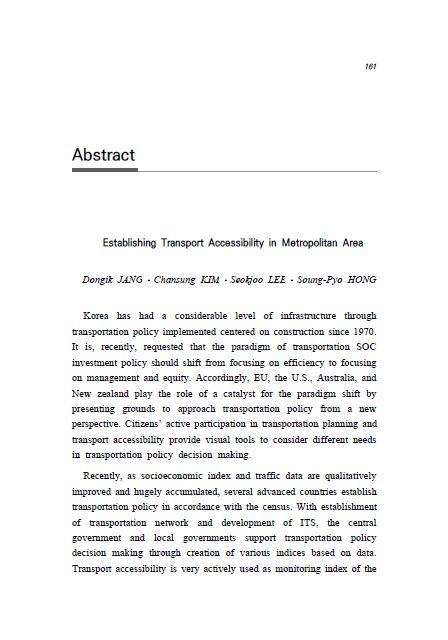Basic Report

RESEARCH
KOTI - Korea Transport institute
Establishing Transport Accessibility in Metropolitan Area
- Date
November 30 2015
- Page(s)
page(s)
#Traffic Accessibility
#Evaluation System
#DB Construction
#Shortest Travel Time Calculation Method

Korea has had a considerable level of infrastructure through transportation policy implemented centered on construction since 1970. It is, recently, requested that the paradigm of transportation SOC investment policy should shift from focusing on efficiency to focusing on management and equity. Accordingly, EU, the U.S., Australia, and New zealand play the role of a catalyst for the paradigm shift by presenting grounds to approach transportation policy from a new perspective. Citizens’ active participation in transportation planning and transport accessibility provide visual tools to consider different needs in transportation policy decision making. Recently, as socioeconomic index and traffic data are qualitatively improved and hugely accumulated, several advanced countries establish transportation policy in accordance with the census. With establishment of transportation network and development of ITS, the central government and local governments support transportation policy decision making through creation of various indices based on data. Transport accessibility is very actively used as monitoring index of the extent of establishing and achieving policy goal at government level. Germany establishes an accessibility plan to reflect socioeconomic factors such as the types and impacts of service provided by several central places. The U.K. has established accessibility-based transportation planning through participation of government agencies such as Department for Transport, Department for Education, Department for Work and Pensions, and Department of Health since the 1990s. The Netherlands pursues ABC location policies, which are strategies of reducing mobility and improving transport accessibility through the use of land and the establishment of traffic system applying the concept of accessibility. This study introduced an evaluation of transport accessibility actively carried out in foreign countries and assessed transport accessibility using traffic DB collected targeting the cases of domestic cities. Based on those assessment results, this study presented methods for evaluating transport accessibility to regions and facilities and for improving the accessibility. Last, this study showed the possibility of evaluating transport accessibility of cities across the nation in the future, as basic study to establish an evaluation system of transport accessibility. The methods for assessing transport accessibility presented by this study include methods for improving transport accessibility of regions and facilities as well as evaluating it. So, those methods are expected to greatly contribute to diagnosing the competitiveness of transport accessibility of Korean cities such as adequacy of facility allocation, usability of residential area, traffic competitiveness, urban traffic congestion and serviceability of public transport, and to improving transport accessibility of underdeveloped regions.